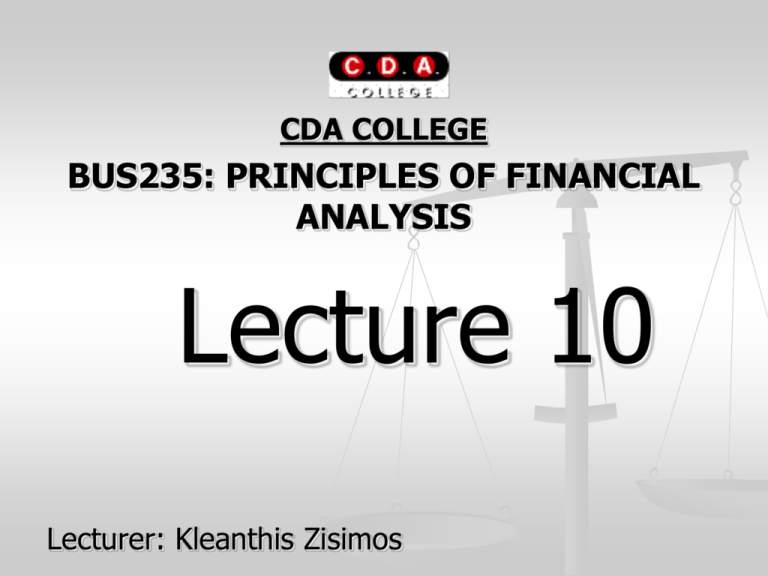Lecture 10 - cda college
advertisement

CDA COLLEGE BUS235: PRINCIPLES OF FINANCIAL ANALYSIS Lecture 10 Lecturer: Kleanthis Zisimos Lecture Topic List What is working capital technology Working capital investments Financing policies Advantages and disadvantages of short term financing Short term bank loans The cash conversion cycle What is Working capital The purpose of this lecture is to explain the nature of working capital and the importance of it to the financial manager. We will also analyze various ratios which help the financial manager to understand how working capital is controlled. Working capital is the name given to net current assets which are available for day-to-day operating activities. Working capital = Current assets- current liabilities Working capital terminology Working Capital = Current assets. Net Working Capital =Current assets minus current liabilities. Current ratio= current assets/ current liabilities Quick or acid test ratio =Measures liquidly and is found by subtracting stock from current assets so the formula is =(CA-stock) / CL Working capital terminology Working Capital Policy = refers to the firm’s basic policies regarding (1) targets levels for each category of current assets and (2) how current assets will be financed. Working Capital Management = involves the administration, within policy guidelines, of current assets and current liabilities. Working Capital Investment policies 1. 2. 3. Investment policies answer to the question of what is the appropriate level for currents assets. We have three alternative policies: Relaxed Current Asset Investment Policy = a policy under which relatively large amounts of cash, marketable securities, and inventories are carried and under which sales are stimulated by a liberal credit policy, resulting in a high level of receivables. Restricted Current Asset inv. policy = a policy under which holding of cash and securities are minimized Moderate current asset inv policy= a policy that is between the relaxed and restricted policies. Working Capital Financing policies 1. 2. 3. Working capital financing policy deals with the issue of how temporary and permanent current assets are financed. We have three approaches Maturity matching approach. It matches current assets and liabilities maturities .This strategy minimizes the risk that the firm will be unable to pay off its maturity obligations. Aggressive Approach = it finances fixed assets with long term capital and part of its permanent current assets with short – term debt. Conservative Approach = Long term capital is being used to finance all permanent asset requirements and also some of the temporary current assets Advantages and disadvantages of short term financing Speed. A short term loan can be obtained much faster than a long term loan Flexibility is increases in short term loans Interest rates are generally lower in short term financing Short term financing is riskier than long term Sources of short term financing Short – term credit is defined as any liability originally scheduled for payment within one year. The sources of short – term funds which are: Accruals Accounts payable (trade credit) Bank loans Commercial paper. Factoring Accruals Accruals are the expenses which are not paid on time like wages, taxes social security However, a firm cannot ordinarily control its accruals: The timing of wage payments is set by economic forces and industry custom, while tax payment dates are established by law. Thus, firms use all the accruals they can, but they have little control over the levels of these accounts. Accounts payable Firms generally make purchases from other firms on credit, recording the debt as an account payable. Accounts payable, or trade credit, is the largest single category of short term debt, representing about 40 percent of the current liabilities of the average nonfinancial corporation. The percentage is somewhat larger for smaller firms: Because small companies often do not qualify for financing from other sources, they rely especially heavily on trade credit. Short term Bank loans Commercial bank loans are second in importance as a source of short term financing. The key features of bank loans are: Maturity = Bank loans are frequently written as 90 – day notes, so the loan must be repaid or renewed at the end of 90 days. Promissory Note = A document specifying the terms and conditions of a loan, including the amount, interest rate, repayment schedule and collaterals. Compensating Balances = A minimum checking account balance that a firm must maintain with a commercial bank, generally equal to 10 to 20 percent of the amount of loans outstanding. Cost of Bank loans 1. 2. 3. The cost of bank loans varies for different types of borrowers at any given point in time, and for all borrowers over time. Interest rates are higher for riskier borrowers, and rates are also higher on smaller loans because of the fixed costs involves in making and servicing loans. Interest rates are calculated in 3 ways Simple interest Discount interest Add on interest Simple interest Regular or Simple rate is the interest that is charged on the basis of the amount borrowed; it is paid when the loan ends rather than when it begins. On a 1-year loan the effective annual rate is Effective annual rate = Interest Amount received Discount interest Discount Interest is the interest that is calculated on the face amount of a loan but is paid in advance. On a 1-year loan the effective annual rate is Effective annual rate = Interest Face Value - interest Add on interest Add – On Interest is the interest that is calculated and added to funds received to determined the face amount of an installment loan. Approximate effective annual rate =Interest (Amount received) / 2 Commercial Paper Commercial Paper is a type of an unsecured promissory note issued by large firms, usually in denominations of €100,000 or more and having an interest rate somewhat below the prime rate. Maturities vary from one month to nine months. The rates also vary according to the market but are closed to the stated prime rates. Commercial paper is never secured, but all other types of loans can be secured if this is deemed necessary or desirable. Factoring Factoring involves the purchase of accounts receivable by the lender without recourse to the borrower which means that if the purchaser does not pay then the lender and not the borrower takes the loss. Since the factoring firm assumes the risk of default it must make the credit check and then proceed with the purchase. The rates are higher than the normal rates of the market Cash Conversion cycle The Cash Conversion Cycle (CCL)is the length of time from the payment for the purchase of raw material to the collection of accounts receivable generated by the sale of the final product. Inventory Conversion period = Inventory Sales/360 Receivables collection period = Receivables Sales/360 Payables deferral period = Payables credit purchases/360 CCL= Inventory Conversion period+ Receivables Collection period – Payables Deferral period





